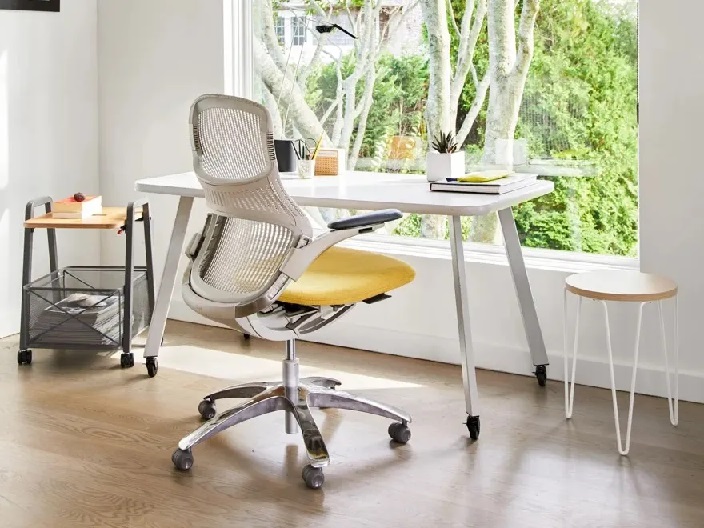Office chairs have come a long way in terms of design and functionality. From the classic wooden chairs of the past to the modern ergonomic designs of today, the evolution of office chairs reflects the changing needs and preferences of workers.
In this article, we will explore the different stages of this evolution, highlighting the key features and innovations that have shaped the office chair industry.
1. Classic Office Chairs
The history of office chairs can be traced back to the early 19th century, when they were primarily made from wood. These classic office chairs were often large and heavy, with a high backrest and armrests. They were designed to provide comfort and support for long hours of work.
As the Industrial Revolution took hold, office chairs began to evolve. The use of steel and other metals became more prevalent, allowing for a more durable and versatile design. The introduction of adjustable features, such as height and tilt, made the chairs more customizable to individual needs.
In the mid-20th century, office chair design took a leap forward with the introduction of ergonomic principles. The focus shifted towards creating chairs that would promote good posture and reduce the risk of musculoskeletal disorders. These chairs incorporated features like lumbar support, adjustable armrests, and contoured seat cushions.
2. The Rise of Task Chairs
In the early 20th century, the rise of industrialization and the increasing demand for office work led to the development of task chairs. These chairs were designed to provide maximum comfort and support for workers who spent long hours sitting at their desks. Task chairs were a revolutionary solution to the ergonomic challenges faced by office workers during this time.
Before their introduction, workers often sat on uncomfortable wooden chairs or stools, which resulted in poor posture and discomfort. The development of task chairs aimed to address these issues and promote a healthier and more productive work environment.
The design of task chairs incorporated several key features to enhance comfort and support. They typically featured adjustable seat heights, allowing individuals to customize the chair to their preferred sitting position. This feature was particularly important for workers of different heights, as it ensured that their feet could rest flat on the ground, preventing strain on the legs and back.
Another significant feature of task chairs was the inclusion of a backrest. This provided essential lumbar support, preventing slouching and promoting proper spinal alignment. The backrests were often adjustable, enabling individuals to recline or sit upright as needed.
Additionally, some task chairs had built-in lumbar support cushions, further enhancing the comfort and ergonomics of the chair. Task chairs also introduced the concept of armrests, which provided additional support for the upper body.
3. The Ergonomic Revolution
In the late 20th century, the focus shifted towards ergonomic design. Ergonomics is the science of designing products and work environments to maximize efficiency and minimize discomfort and injuries. This shift in focus was a response to the growing recognition that many traditional designs were causing physical strain and stress on individuals.
The ergonomic design takes into account the natural capabilities and limitations of the human body, aiming to create products and workspaces that promote health, comfort, and productivity. One key aspect of ergonomic design is the consideration of human anthropometry. This involves understanding the measurements and proportions of the human body and using this knowledge to create products that fit well and are easy to use.
For example, ergonomic chairs are designed with adjustable features to accommodate different body sizes and promote proper posture. Another important factor in ergonomic design is the reduction of repetitive motion and excessive physical exertion.
This is particularly relevant in work environments where individuals may perform tasks that require repetitive movements, such as typing or assembly line work. By incorporating ergonomic principles, such as providing proper wrist support or optimizing workstation layout, these tasks can be performed more comfortably and with less risk of injury.
4. The Future of Office Chairs
The evolution of office chairs continues to this day, with new designs and technologies being introduced. One of the recent trends is the integration of technology into office chairs. This integration of technology into office chairs aims to enhance comfort, productivity, and overall user experience.
One popular feature is the incorporation of adjustable lumbar support, which allows users to customize the chair’s backrest to their specific needs. This helps alleviate back and posture-related issues that are common among office workers. Another advancement is the introduction of ergonomic designs that promote better sitting posture.
These chairs often come with adjustable armrests, seat height, and tilt mechanisms, allowing users to find their optimal seating position. Some chairs even include sensors that detect the user’s posture and provide real-time feedback, reminding them to sit up straight or take breaks. In addition to comfort, technology has also been integrated into office chairs to enhance connectivity.
Many chairs now come equipped with USB ports or wireless charging capabilities, allowing users to charge their devices conveniently while working. Some chairs even have built-in speakers or Bluetooth connectivity, enabling users to listen to music or take calls without the need for additional devices.
Conclusion
The evolution of office chairs reflects the ever-changing needs and preferences of workers. From the classic wooden chairs of the past to the modern ergonomic designs of today, office chairs have evolved to provide maximum comfort, support, and mobility. As technology advances and sustainability becomes a priority, we can expect to see even more innovative and eco-friendly designs in the future.
